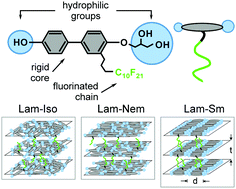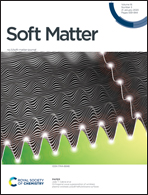Frustration between two- and three-dimensional smectic ordering leads to a biaxial nematic phase†
Abstract
The bola-amphiphilic, T-shaped mesogen CT2 has an aromatic, biphenyl core terminated on both ends by hydrophilic groups and a semi-perfluorinated, aliphatic side chain. Upon cooling from the isotropic phase, the fluorinated tails and the polar, rod-like cores nanophase-segregate to form a fluid lamellar phase. At high temperatures, the biphenyl cores are orientationally disordered in two dimensions (2D) in the lamellar planes but on further cooling the cores order orientationally, giving a biaxial lamellar phase with 2D nematic in-plane ordering. At lower temperature, the aromatic and hydrophilic parts of the cores nanosegregate within the lamellae and 2D smectic correlations of the head groups develop. X-ray diffraction shows that this 2D smectic ordering is incompatible with the initial lamellar structure, with both structures becoming short-ranged, resulting in a 3D biaxial nematic phase with macroscopic orthorhombic symmetry featuring strong smectic correlations in two orthogonal spatial dimensions. Freeze-fracture transmission electron microscopy enables direct visualization of the resulting short-ranged periodic structures.



 Please wait while we load your content...
Please wait while we load your content...